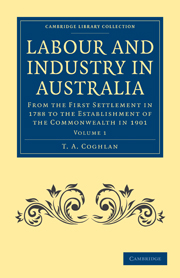 Labour and Industry in Australia
Labour and Industry in Australia Book contents
- Frontmatter
- PREFACE
- Contents
- PART I FROM THE FOUNDATION OF SETTLEMENT TO THE CROSSING OF THE MOUNTAINS
- PART II FROM THE CROSSING OF THE MOUNTAINS TO THE ABOLITION OF THE ASSIGNMENT SYSTEM
- I INTRODUCTION TO THE SECOND PERIOD
- II CONVICT LABOUR: ASSIGNMENT
- III FREE LABOUR
- IV IMMIGRATION
- V THE OCCUPATION OF LAND
- VI AGRICULTURAL AND PASTORAL PURSUITS
- VII THE CURRENCY
- VIII TRADE AND PRICES
- PART III FROM THE ABOLITION OF THE ASSIGNMENT SYSTEM TO THE DISCOVERY OF GOLD
- PART IV FROM THE DISCOVERY OF GOLD TO THE INTRODUCTION OF FREE SELECTION OF LAND BEFORE SURVEY
VIII - TRADE AND PRICES
Published online by Cambridge University Press: 05 August 2011
- Frontmatter
- PREFACE
- Contents
- PART I FROM THE FOUNDATION OF SETTLEMENT TO THE CROSSING OF THE MOUNTAINS
- PART II FROM THE CROSSING OF THE MOUNTAINS TO THE ABOLITION OF THE ASSIGNMENT SYSTEM
- I INTRODUCTION TO THE SECOND PERIOD
- II CONVICT LABOUR: ASSIGNMENT
- III FREE LABOUR
- IV IMMIGRATION
- V THE OCCUPATION OF LAND
- VI AGRICULTURAL AND PASTORAL PURSUITS
- VII THE CURRENCY
- VIII TRADE AND PRICES
- PART III FROM THE ABOLITION OF THE ASSIGNMENT SYSTEM TO THE DISCOVERY OF GOLD
- PART IV FROM THE DISCOVERY OF GOLD TO THE INTRODUCTION OF FREE SELECTION OF LAND BEFORE SURVEY
Summary
The commerce of Australia developed very much after 1820, but the imports remained so largely in excess of the exports as to constitute at times a source of serious financial difficulty. This excess represented the inbringings of immigrants and the imports on Government account due to the requirements of the convict settlements, and its extent may be gathered from the fact that in 1825 imports were valued at £388,161 and exports at £123,837; from 1826 to 1830 the average yearly trade was imports £667,000 and exports £209,000, and from 1831 to 1835 imports £1,204,000 and exports £670,000.
The trade of the colony was carried on chiefly with England and her dependencies. Thus in 1828, half-way through the second period, when the value of goods imported into New South Wales was £570,000, the share of the United Kingdom was £399,892, whilst goods brought from British colonies were valued at £125,862, and £44,246 represented the value of the imports from foreign states. In the distribution of the exported goods there was a still greater disproportion. Taking the same year, the exports to the United Kingdom were valued at £84,008, those to the British colonies at £4845, and those to foreign countries at £1197 only.
A glance at the list of imports shows that the emergence of the settlements from the convict stage was in rapid progress.
- Type
- Chapter
- Information
- Labour and Industry in AustraliaFrom the First Settlement in 1788 to the Establishment of the Commonwealth in 1901, pp. 274 - 290Publisher: Cambridge University PressPrint publication year: 2011First published in: 1918


